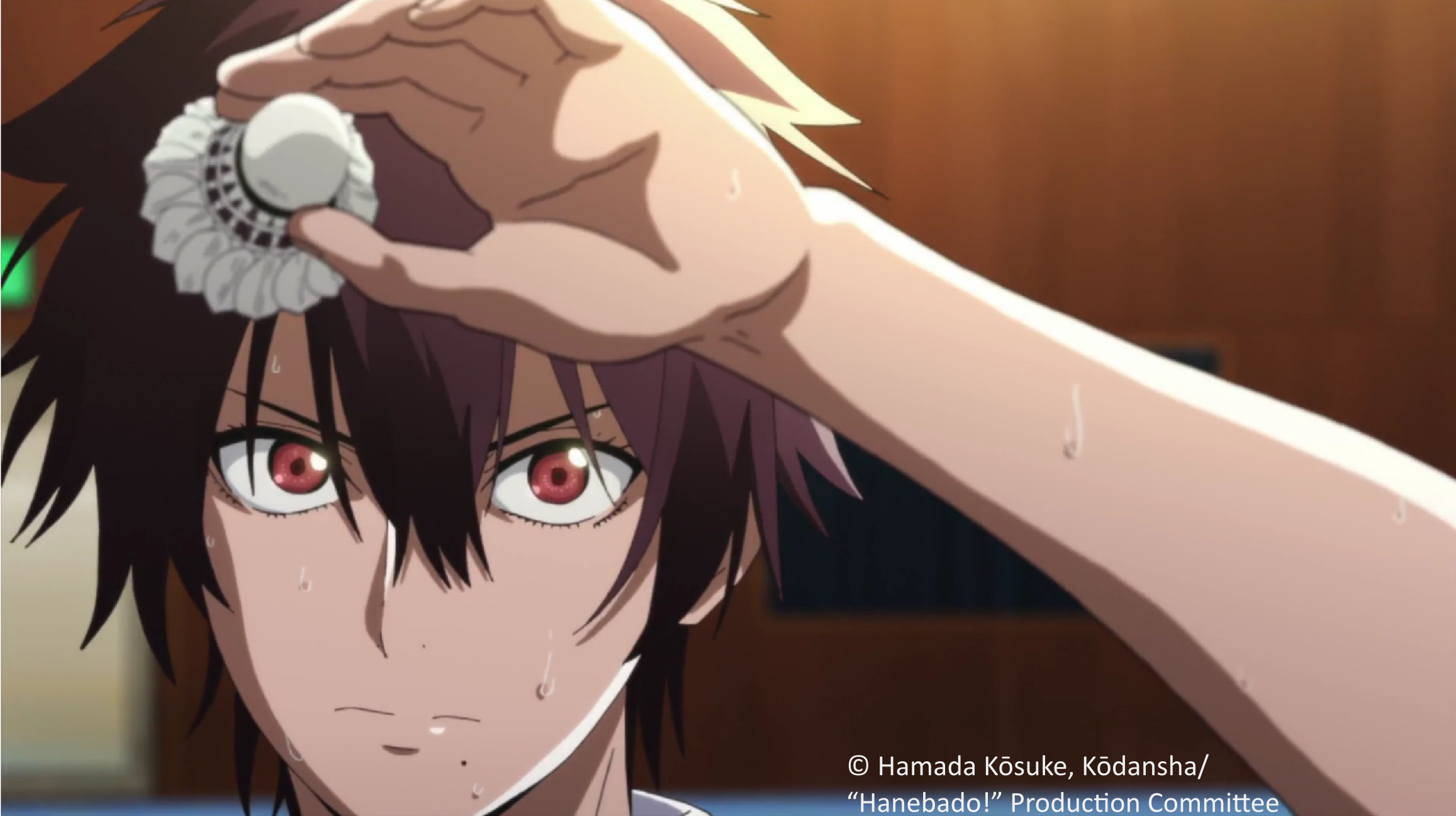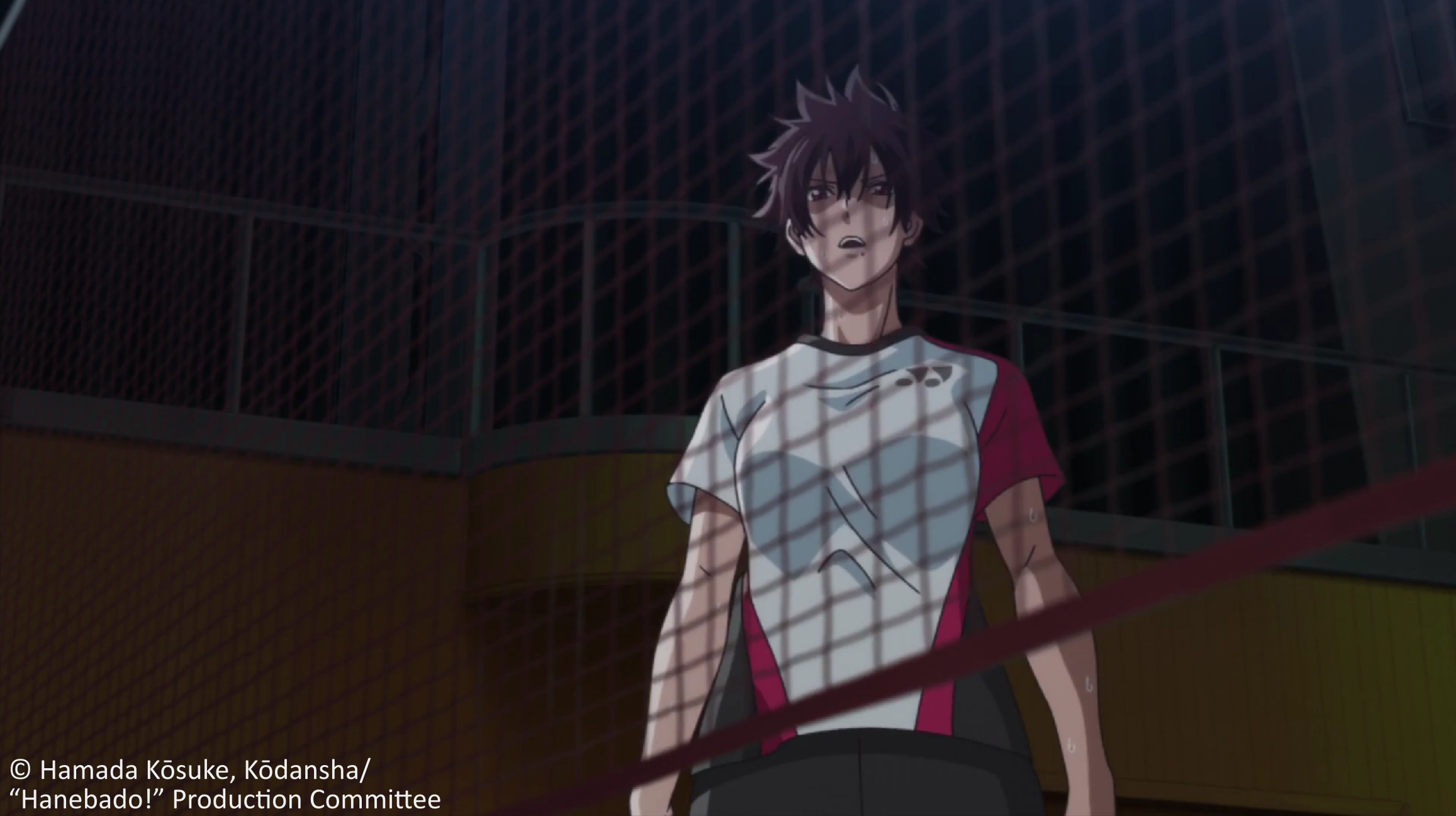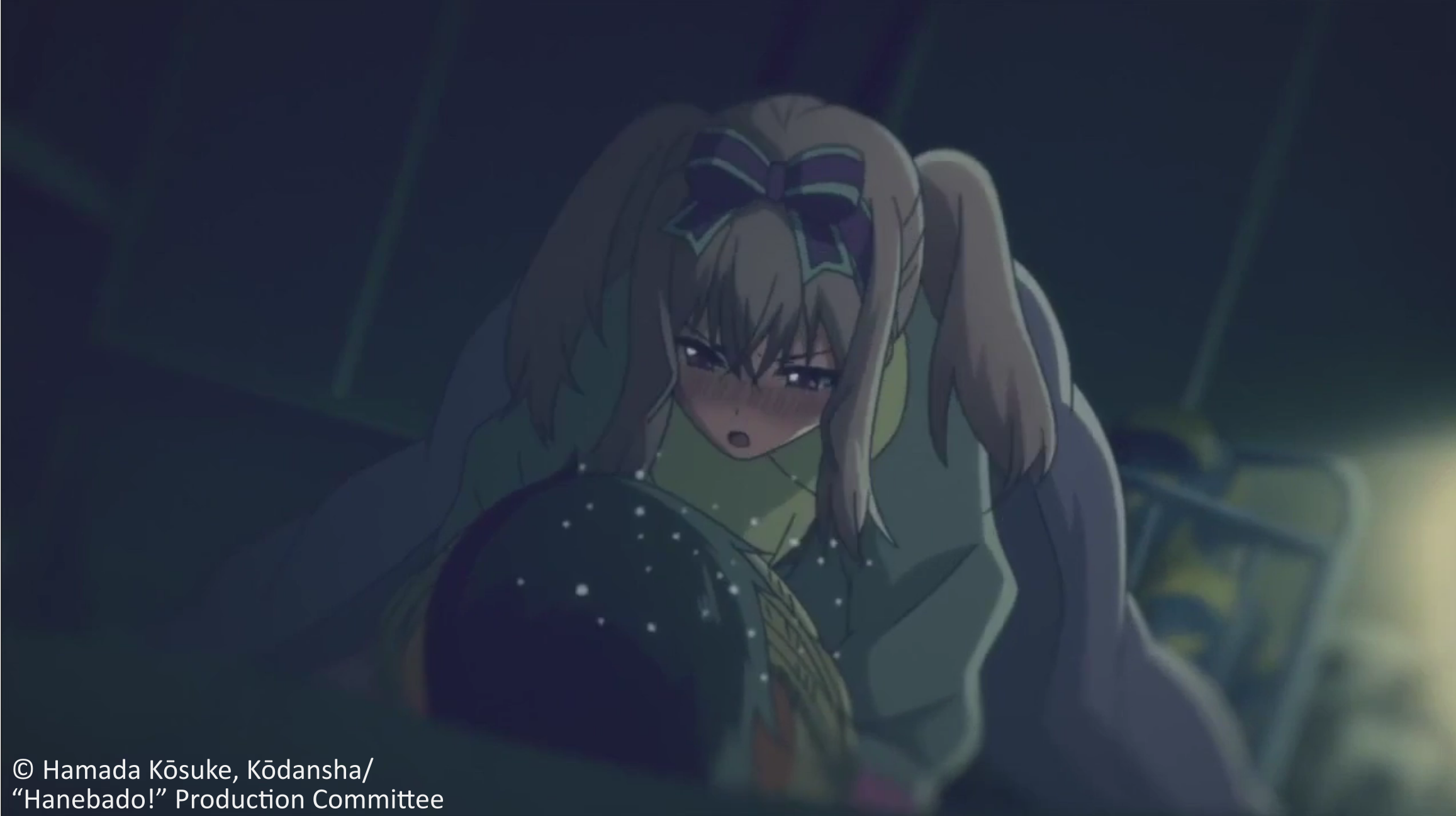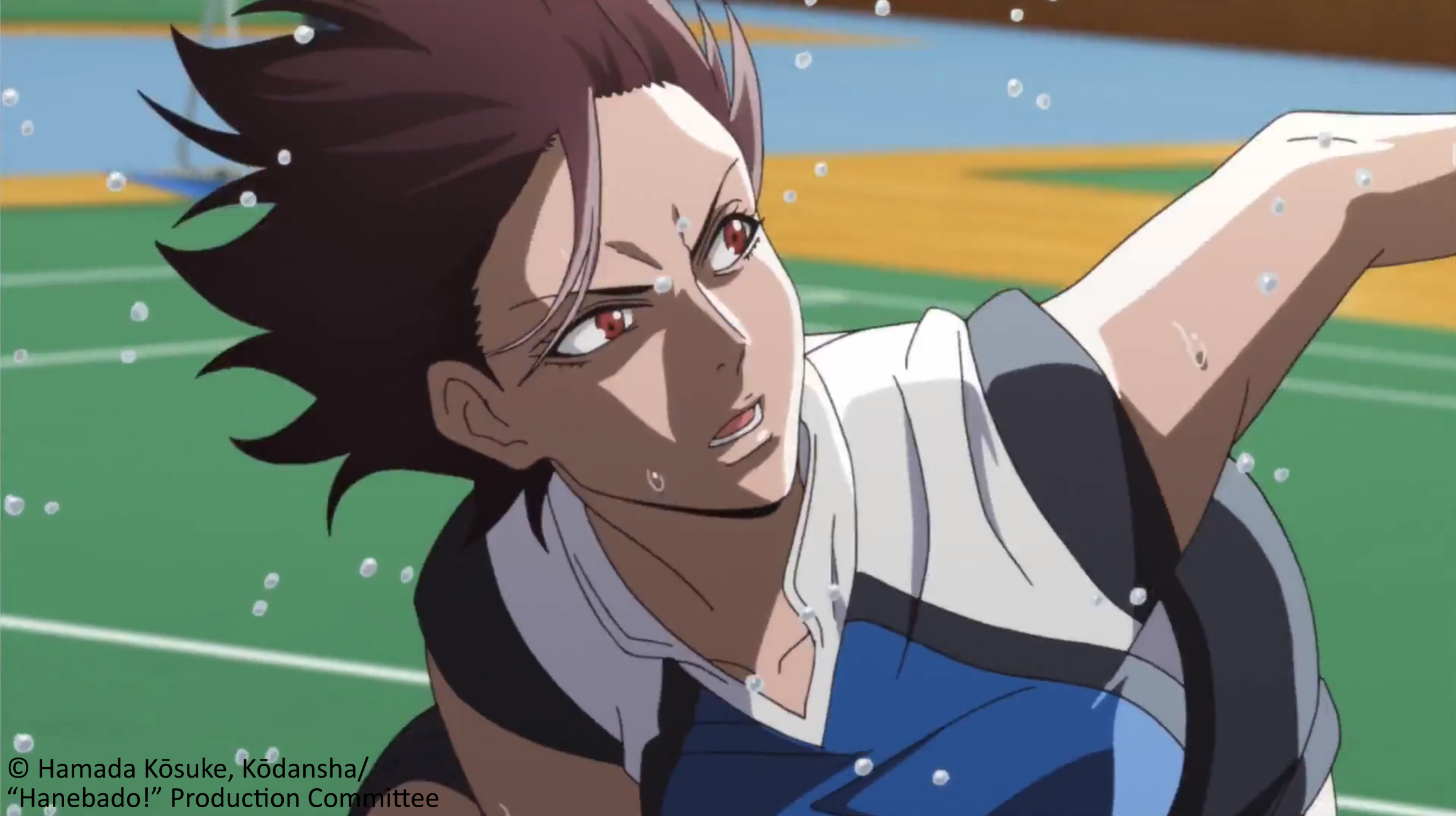Hanebado! is a wonderful anime. It pulls at your heartstrings but also makes you gasp in horror and disbelief. There’s no need to worry, though! Many small happy endings will engulf you in a warm, fuzzy feeling and put a smile on your face. The girls’ and boys’ passion for badminton sustains them throughout their athletic and mental struggles. Watching them chase the shuttle across the court in high-paced rallies will convince you that badminton is a thrilling and breathtaking sport for athletes and spectators alike.

Jiggle, Jiggle, …
My greatest fear when I start watching a girl-focused sports anime is depictions of overly sexualized or overly infantilized girls and women. While Nagisa and a few other characters are quite ‘well-developed’, over-sexualized depictions as well as infantile behavior were kept at a bearable level. To my relief, I wasn’t exposed to tinnitus-inducing, high-pitched female voices either. All these would’ve been reasons to drop the anime and look for another story. Still, during the matches, when the girls run and jump, skirts and shirts flutter generously, while gravity and Newton’s law of motion induce their bosoms to bounce vigorously. Oh, and here’s something interesting: breast biomechanics and motion is a field of study, and from what I’ve gathered, it’s particularly important with regard to adequate breast support during sports. The gaming industry (and surely other types of animation as well) also busied itself with the study of the proper wobbling and jiggling of female breasts, called ‘jiggle physics’ or, more neutrally, ‘breast bounce.’

So sorry! I got sidetracked. Let’s return to the anime.
Fated Rivals
The anime starts with a match at the Olympics National Junior Badminton Tournament between Aragaki Nagisa, a member of the Kitakomachi High School badminton club, and the middle schooler Hanesaki Ayano. We only get to see the final moments of the match, but the high-paced exchange grabbed my attention right off the bat. “This might even be a good anime,” I thought.
Sweat poured in streams down Nagisa’s athletic body, and her fierce determination to smash the ever-returning shuttle onto the opponent’s court radiated from her every move. In stark contrast to Ayano, who, despite her small build, exuded an air of relaxed calm. Her slender arms effortlessly pinpointed the shuttle and sent Nagisa running across the court. In the end, Nagisa lost the chase without having scored a single point. She sank to the floor and asked herself the story’s central question: “What have I been doing this for? What am I playing badminton for?”
Ayano could’ve rejoiced over this phenomenal victory. Instead, her blank stare and the tears that dripped from her cheeks bore witness to her dejection as she, too, asked herself, “What am I playing badminton for?”

We will be confronted with this question repeatedly throughout the anime. And if you’ve ever poured your all into pursuing a desired goal and, after an arduous struggle, arrived at a point beyond exhaustion, you might’ve asked yourself the same question. What am I doing this for? Why am I doing this… to myself?
But, before we search for an answer to this crucial question, let’s get to know two main characters a little better.
A 45-Minute Race
The anime’s title, and even more so the subtitle of the manga—The Badminton play of Ayano Hanesaki —already give away that the protagonist of the story is the victorious yet downcast girl, Ayano.
However, her story isn’t picked up until episode three because the first two episodes focus on another girl: Kitakomachi High’s third-year Aragaki Nagisa. Who would’ve thought that you could squeeze a character’s transformation into roughly 45 minutes? And what a transformation it was! Within two episodes, Nagisa’s mindset and emotional state took a 180-degree turn. Trying to keep up with the breakneck speed of her development from an aggressive and mean teenager into a considerate and mature young woman left me quite out of breath and a little bewildered.
Since Nagisa’s character arc is crammed into two episodes, there’s no time for long-winded detours, emotional ups and downs, and psychological deep-dives. This is reserved for Ayano. So, when we meet Nagisa again, six months after the tournament, the effects of the bitter defeat have already taken root in her heart. With victory over Ayano as her single focus, she trained hard and expected her team to do likewise: “If we want to win, we need to practice. We are not prodigies, so we need to train hard.” She frowned at minor mistakes, shouted at the club’s members to train harder, and denigrated those who couldn’t or didn’t want to keep up with her. She became the perfect example of an oppressive and aggressive captain.

Until, with no noticeable outside trigger or decisive incident, her aggressive, “We must train hard!” changed to an apologetic and teary-eyed, “I’m the one who’s not cut out for this. I blame other people for what I can’t do.”
The Good Captain
I don’t know much about badminton apart from the things I learned from watching Ryman’s Club and Love All Play more than a year ago, which wasn’t much, I’m afraid. I do remember, though, that a single skill like foresight or intense focus can give you the edge over your rivals. Now, instead of foresight and focus, Nagisa possesses her powerful smash. As is often the case with character development, improvement comes from learning a new skill or a variation of an already existing one. Therefore, I expected that she’d be taught the decisive technique by the new coach, Tachibana Kentarō, which she’d then train to perfection for her final match. But I was wrong. Nagisa stubbornly insisted on using just her smash, which suddenly turned from being a burden into a blessing: “Everything I’ve done hasn’t been in vain. I have my smash.” And once coach Tachibana told her that “it’s ok to put faith in your smashes,” all her doubts and worries evaporated: “What was I so unsure about? I’ve trained more than anyone.”

And with that, Nagisa’s transformation from Beast into Bambi is concluded. Episode two ends with her bowing doe-eyed to her teammates, who happily accept her apology without further ado.
Exhausted from this high-speed race, I hoped that the next episode would give me a little breather, but I wasn’t allowed any rest. Because with episode three, the really heavy stuff started.
The Mother
Once more, we fast forward six months after the national tournament, when Ayano has just entered Kitakomachi High School as a first-year. A flashback reveals that she’s the daughter of the famous Uchika, the ten-time consecutive victor of the National Badminton Championships. Ayano has played with and against her mother since she was little and has developed outstanding reflexes and a sense of the game. Yet, one fateful day, she lost to her opponent due to being sick and was immediately abandoned by her mother without explanation. You don’t have to be a parent to shake your head at the incomprehensible and detestable act of that woman. Only someone with a heart of stone could walk out the door and leave their feverish child behind without so much as a glance back.
I was baffled, that except for Ayano’s own opinion about and her behavior toward her mother, Uchika’s deed wasn’t criticized once. Not by Ayano’s closest friend Erena, nor by the grandparents who were left in charge of the child, nor by the coach when he found out about it. Asked by Erena near the end of the series why she left her daughter behind, the mother answered smilingly, “I know I’ve done something unforgivable. But I have no regrets.” How in the world could you portray a mother’s behavior like that and not criticize it through the other characters? I mean, make at least one person say that the decision to leave her child like that was unacceptable.

Anyway, I think I’ve found a way to curb my rising anger and offer an explanation for the horrible turn this story took.
The Surrogate Mother(s)
After Ayano was abandoned, she kept playing badminton and tried hard to improve to regain her mother’s affection. Unfortunately, Uchika found another promising young athlete in a foreign country, Connie Christensen, whom she adopted to raise to stardom. Ayano’s victory against Nagisa came too late… so she decided to stop pursuing her mother’s love and quit badminton.
Luckily, Ayano wasn’t completely alone because her childhood friend Erena was always by her side. When Uchika was still in Japan, Erena spent her free time watching rally after rally between Ayano and her mother. After Uchika left, Erena took on the roles of chaperone and mother. Insecure in every aspect of life and unable to make decisions on her own, the badminton prodigy clung to her friend like a toddler to her mother. Naturally, she followed Erena to the same high school, Kitakomachi High, which, as you know, is also the center of Nagisa’s school and sports life.
Erena was convinced that playing badminton would be good for Ayano’s independence. But Ayano wasn’t interested because she’d already quit doing sports. To overcome her friend’s resistance, she decided to support Kitakomachi’s badminton club as manager. Ayano, who didn’t know her way around the world without the guidance of her childhood friend, had no choice but to join the club as well. The drawback of being the protagonist is that they can’t escape facing trials and being tested. And after joining the unfamiliar badminton club, Ayano too had to face her worst enemies: human interactions and making friends. The Kitakomachi team put every effort into making her feel welcome and comfortable. At first, she clung tightly to her surrogate mother’s apron, but little by little, she started to enjoy spending time with her teammates. Constantly blushing at the smallest kindnesses, she slowly opened her heart to the idea of having friends and being part of a team. Until Connie showed up.

Good Girl Gone Bad
Sadly, the cautiously budding friendships were crushed when her mother’s adopted daughter-athlete, Connie, appeared out of the blue and reminded Ayano, “Even if you have a team, in the end, if Mama doesn’t acknowledge you, there’s no point in playing badminton, is there?” Upon hearing this, Ayano reverted to her former self, rejected her teammates, and isolated herself more and more. Her sweet and ever-blushing innocence was replaced by spiteful arrogance and a condescending demeanor. With each episode, the cracks in her mask of stiff friendliness grew, and, in the end, taunting and scornful remarks flowed unrestrained from her lips. She turned into a despicable character, a villain, if you will. Her emotional development is understandable and, therefore, all the more heartbreaking. But what is truly remarkable is her physical transformation!
Since episode one, Ayano was a slender girl, more child than adolescent, with sticks for arms and a round face with big, timid eyes. However, fighting against Nagisa in the final match, the small girl turned into a grown woman with a curved body and visibly muscular arms. Her innocent and bashful smile was exchanged for the fierce and menacing stare of a crouching beast.

The Moral Of The Story
And yet, despite her vile behavior and her scary physical transformation, her team stood by her. During the final match (against Nagisa), her teammates and her former opponents cheered for her, and even Nagisa encouraged her—in her own way. Why?
Well, this is where we learn about the morale of this tale: the power of the team! Invigorated by the cheers and encouragement of her team and ‘friends,’ Ayano suddenly finds joy in playing badminton and in going up against an overpowering Nagisa. She shrinks back to her former build, apologizes for her conduct, forgives her mother, and chooses to stay with the team that welcomes her with open arms. Thus, the team helps Ayano overcome the trauma caused by her mother. What incredible power…
By the way, Connie also learned that team equals family. After falling from proud and arrogant heights because of a humbling cramp, she apologized to her doubles-partner, whom she treated very condescendingly. Thanks to some jolly splish-splash bordering on sexual harassment in the bathhouse, Connie succumbs to the team’s charm and is welcomed back into the bosom of her new ‘family.’
Ayano’s mother, too, acknowledged the powerful influence of this surrogate family: “I know I’ve done something unforgivable. But I have no regrets. Right now, she’s on the verge of taking a new step. That’s thanks to you and the members of the club who stayed by her side.” Indeed, Uchika only left her daughter behind because she was convinced this was the only way to improve Ayano’s badminton skills. And, as we can see, her plan came to fruition. I’m in no position to discuss good or bad parenting, but I’m sure there would’ve been alternative ways to support her daughter without traumatizing her. Thankfully, Ayano found a new family—the badminton team.
Let’s leave Uchika behind for now and focus on two other characters with ill intent.

Bad Intentions
Besides Uchika, the two ‘Sailer Moon’-girls also stressed my misbehavior-tolerance level: Connie, the blonde adopted daughter-athlete, and the pink-haired Kaoruko, who had caused Ayano’s first defeat ever. Their character introduction, arrogant air, and physical appearance tempted me to move the curser toward the ‘exit’ button. Shortly after they first met, Connie intentionally provoked and dissed Ayano. Yet, half-way through the series, she suddenly uttered her true desire with such desperate yearning that it made me wonder why she has been so haughty and cold in the first place: she wanted the three of them, Connie, Uchika, and Ayano, to be a family. I raised my eyebrows at this incomprehensible character shift but shrugged it off with the thought that some things are meant to remain a mystery.
Kaoruko, the pink-haired ‘Sailor Moon’-girl, reminded me that Hanebado! aired before the COVID-19 pandemic. She was the first to ever beat Ayano. But Kaoruko only won because she played dirty… or rather, sick. Before their match, face flushed and cheeks burning from the cold she caught, Kaoruko attacked the unaware Ayano in the equipment room and coughed right into her face to, as she said, “play Ayano on even terms.” And it worked. Ayano got sick, lost, and was abandoned by her mother. Deliberately passing on a virus is reprehensible, but this scene was clearly meant as comic relief, so no harm done, right? Well, even though COVID-19 is finally behind us, the memories are likely still fresh in many people’s minds. So, those of us who watched the anime after the pandemic might not have found this scene as funny as it was intended.

Since you’ll never know if a virus lurks around the corner, it’s best to strengthen your immune system and keep your U-1146 in top condition.
What Am I Doing This For?
Just as Connie and Kaoruko, the other girls and boys, each had their own reasons for playing badminton. They endured intense training, and some even practiced after the regular sessions. Yet they had to deal with defeats and setbacks despite their efforts. Why would you go through all this and still continue?
To get the final answer(s), you’ll have to watch all thirteen episodes. The last episode, in particular, addresses this pivotal question in a beautiful and expressive way. However, you’ll have to follow the struggles, doubts, and anxieties of the teenagers and watch them grow mentally and athletically as they strive to reach their respective goals. When the final game between the fated rivals, Nagisa and Ayano, starts, and its rallies as well as its climax make you hold your breath, you’ll appreciate having been a part of their journey, and you’ll be able to relate to the characters’ passionate feelings for this sport.
The silent voices of the individual athletes tied in with the last moments of the game resonated within my heart. And, I guess, these scenes will touch anyone who has ever poured their soul into something that is difficult to achieve yet they desire with all their heart, be it in sports or something else. Why do we accept hardships, fight against odds, and suffer through difficult times, yet keep going nonetheless? The reasons are manifold, as the anime shows, but either the path or the goal, maybe even both, are worth every ounce of effort and every single drop of sweat.

Badminton Rules!
Apart from a few irritating parts, Hanebado! held my attention from beginning to end and released me sighing happily. Even though no technical parts of the sport are explained except a few, mainly strategical, plays, badminton rules this anime. Passion for the game goes before passion for romance. This is bad news for those of you who are looking for a romantic story. In this case, you should rather check out the volleyball manga Shojo Fight!. During the rallies, I couldn’t take my eyes off the heavily sweating girls (and the few boys) swinging their rackets fervently as they strove to beat their opponent while fighting their inner demons. Chasing the swiftly approaching shuttles alongside the young athletes, I was astonished at how exciting badminton is.
Lastly, I have one (small) complaint. I’m used to seeing teenage athletes in sports anime (as well as manga and manhwa) train and play despite injuries. Yet, I’m still very critical of this depiction and couldn’t help but frown in disapproval when coach Tachibana didn’t prevent Nagisa from playing in the final match with an injured knee. Telling him she actually doesn’t fight her opponent but herself, he yielded with a smile. Coaches should know better; in popular culture, however, few ever do. Well, in the end, I’m glad that she decided to play because the final was awesome! And, to my relief, the serious, career-threatening injury turned out to be no biggie. Phew! No need for a bad conscience, after all.
So, if you are looking for a gripping yet heart-rending as well as heartwarming sports anime, Hanebado! is a great choice.

Links:
- Anime: Hanebado!
- Manga: Hanebado! The Badminton play of Ayano Hanesaki
- Cells at Work: manga and anime
Subscribe to never miss a deep dive into the exciting world of sports anime, manga, and manhwa!


[…] “Hanebado!” – What Am I Doing This For? […]